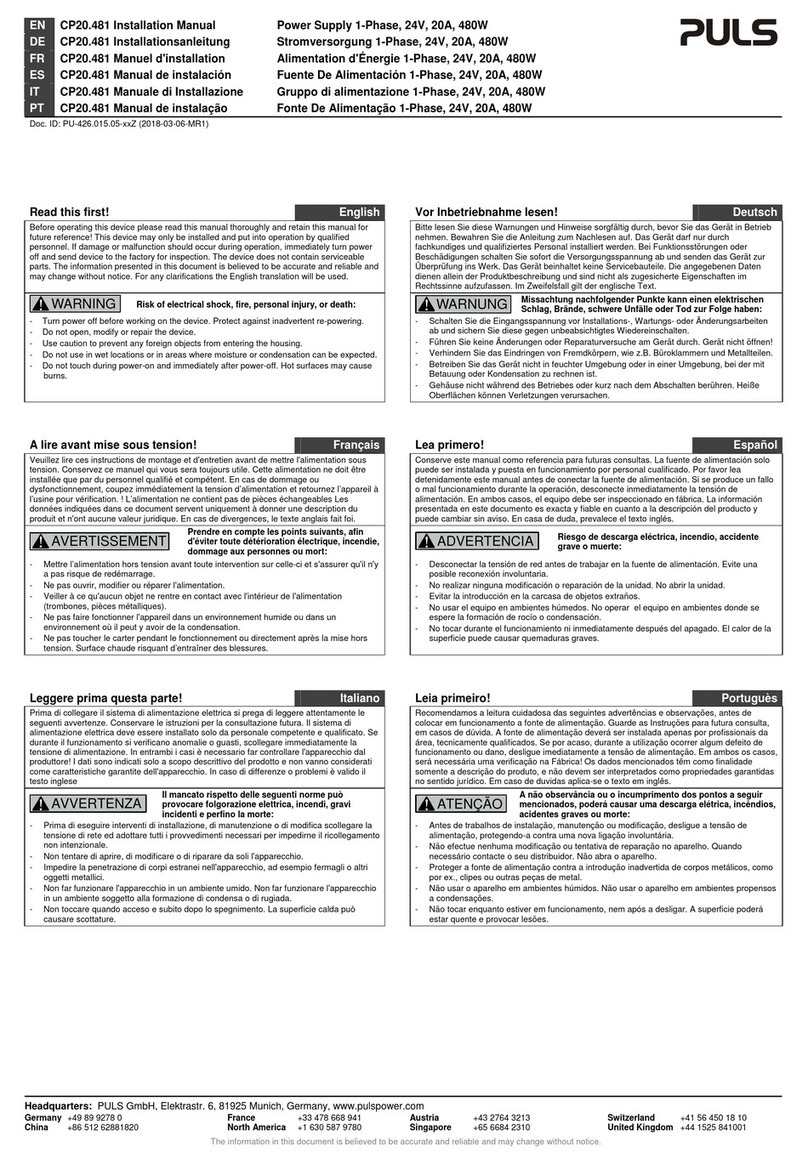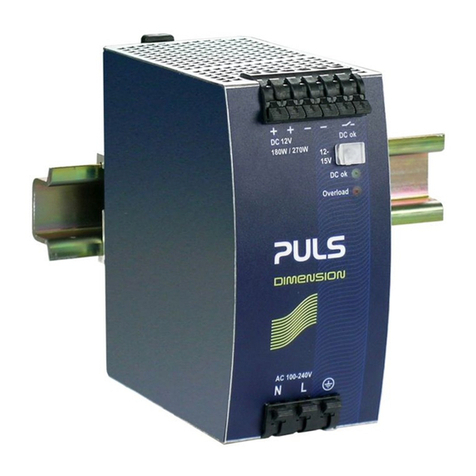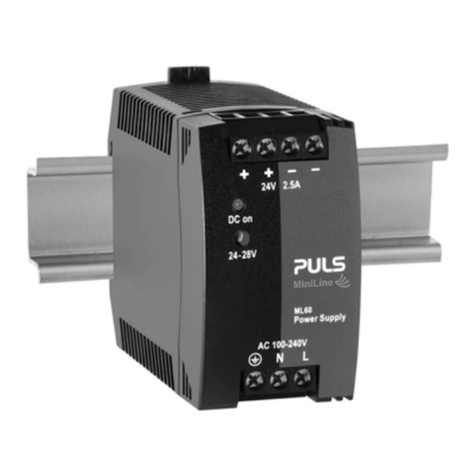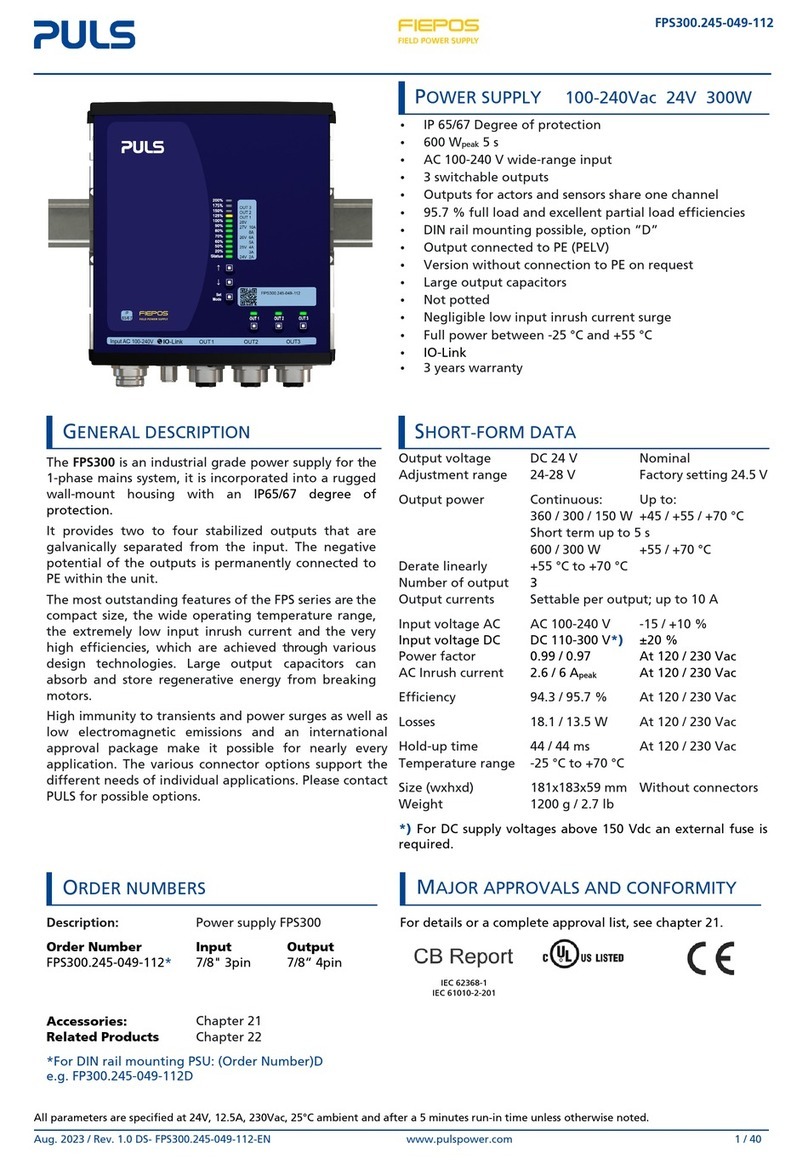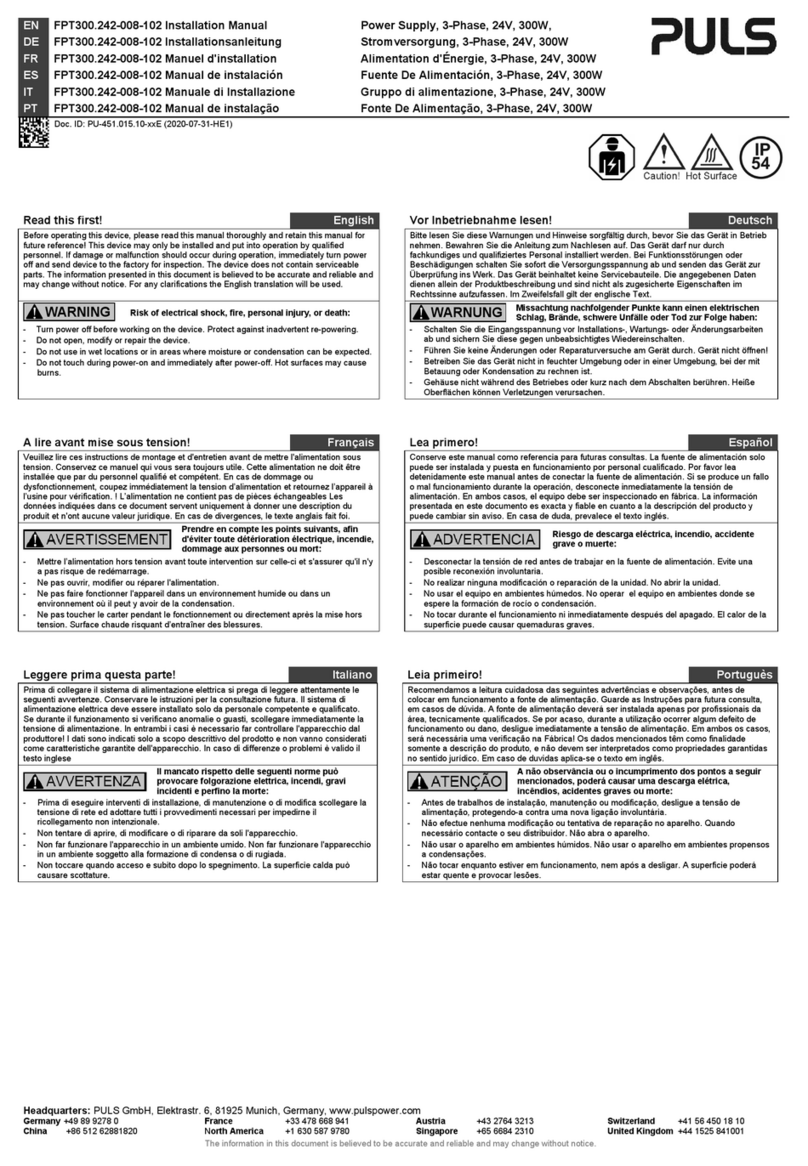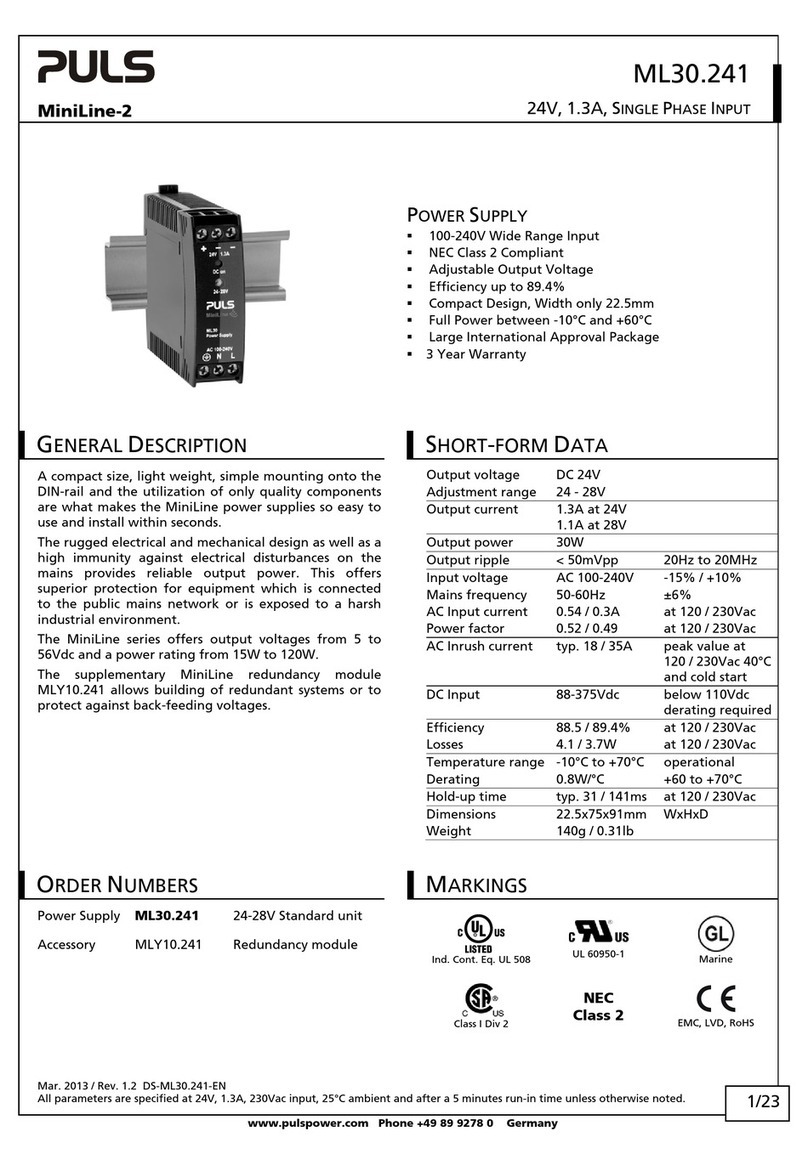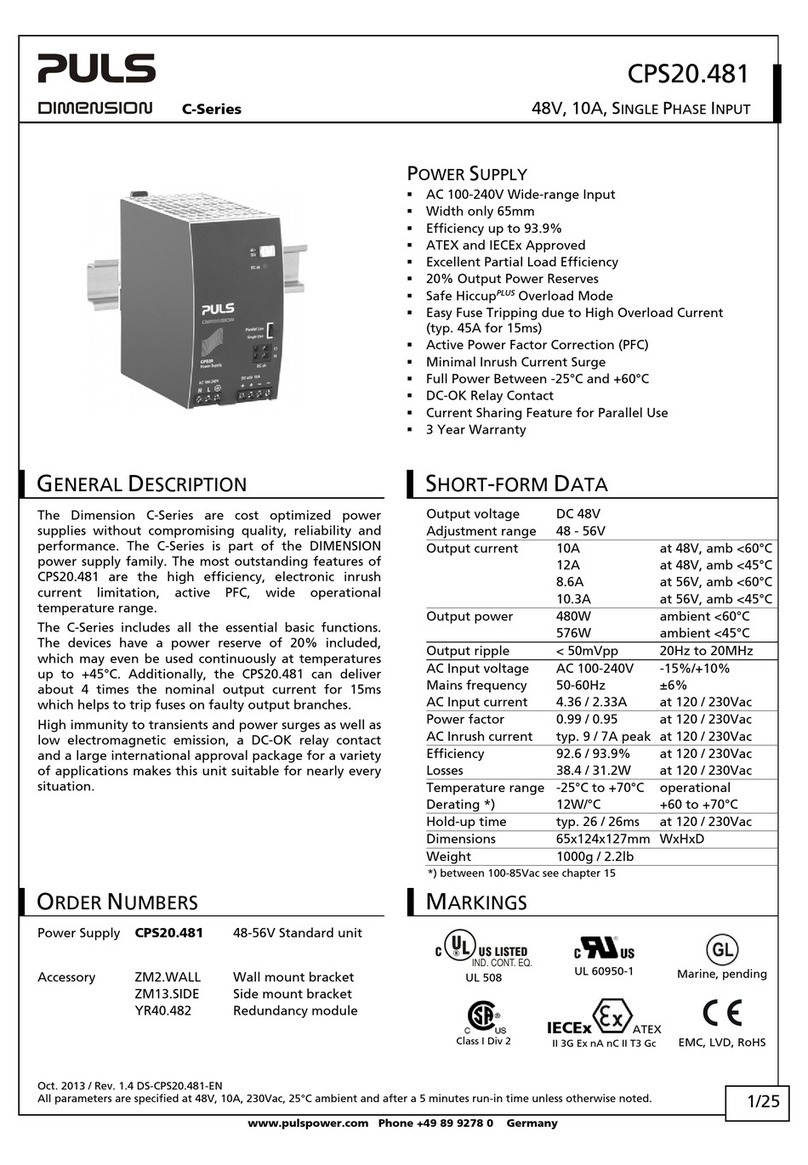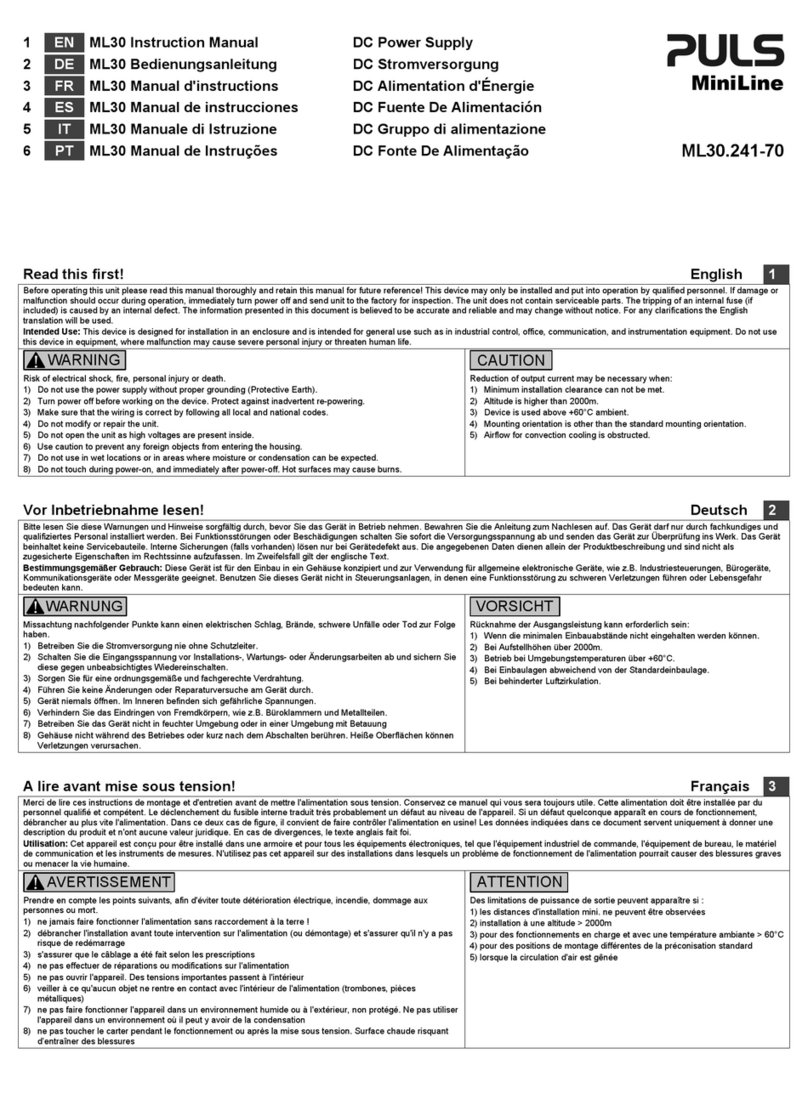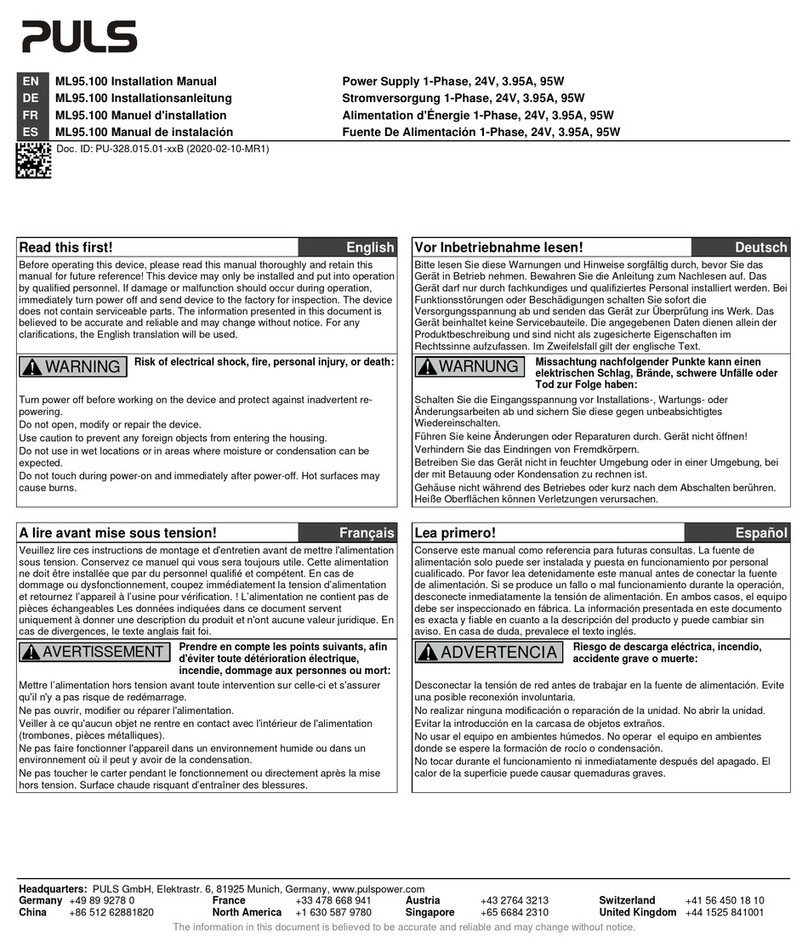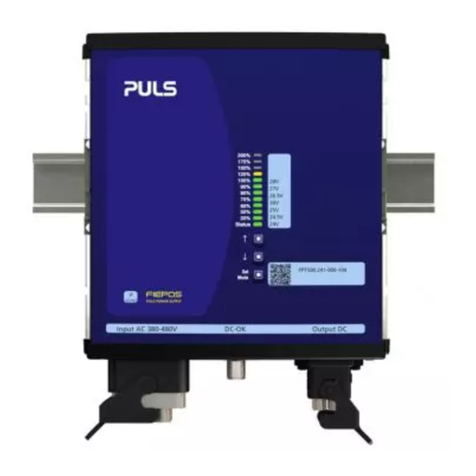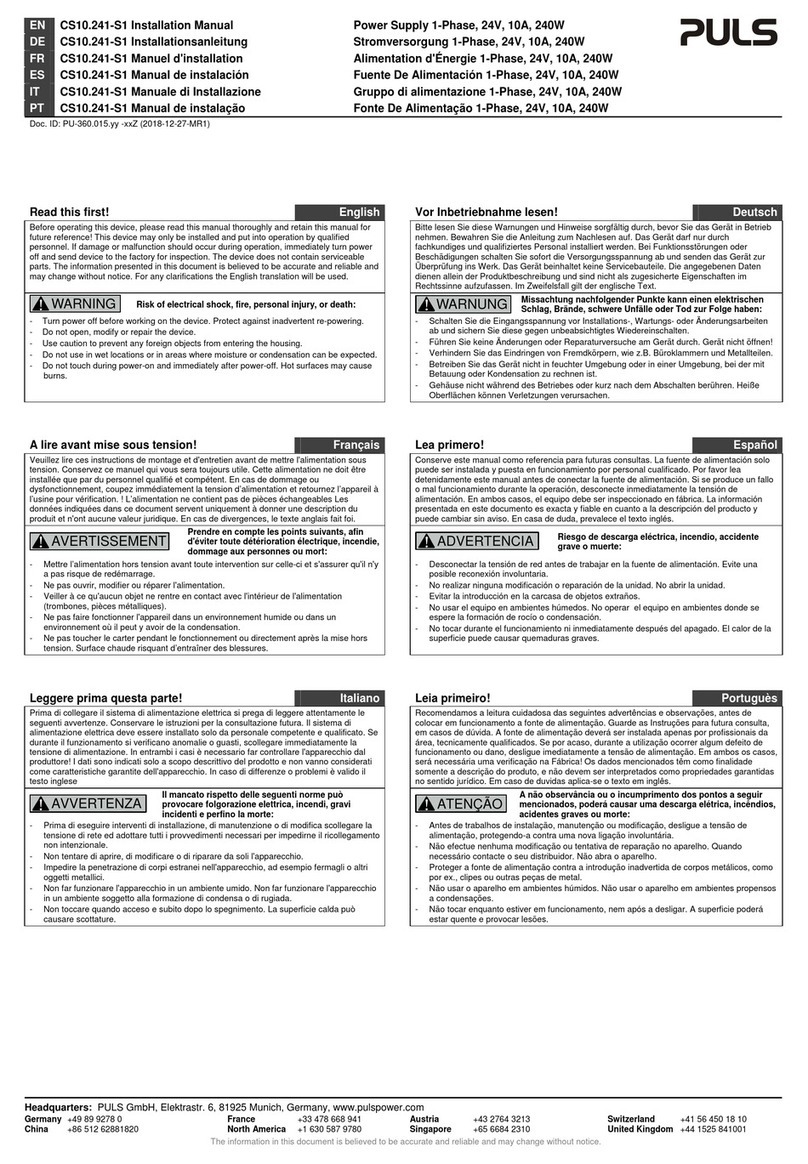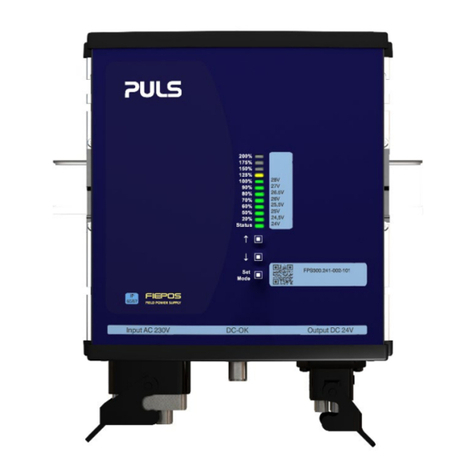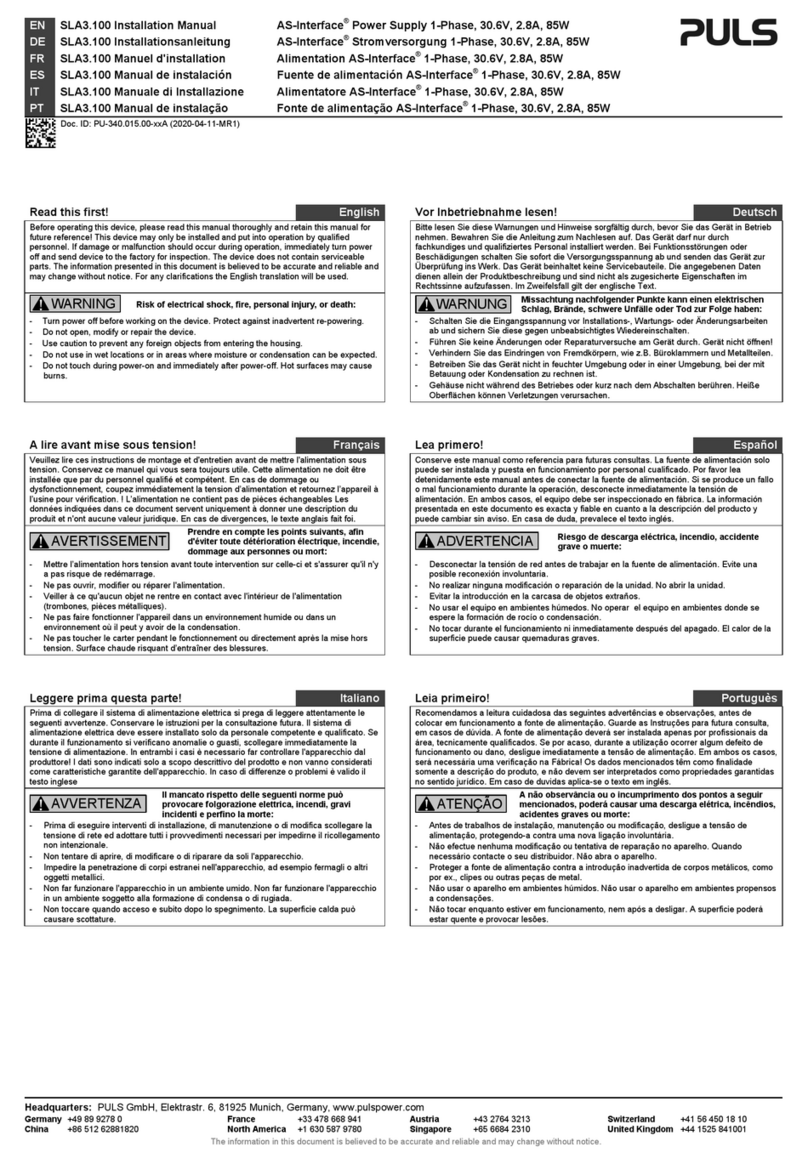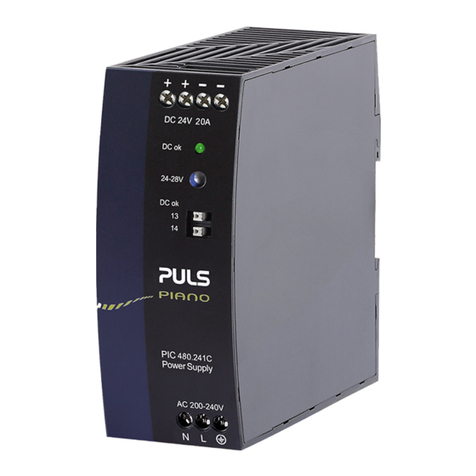PISA11.CLASS2 Instruction Manual
PISA11.CLASS2 Bedienungsanleitung
Technical Data 1) Technische Daten
1) PISA11.CLASS2
Rated Voltage Nennspannung nom. DC 24V
Input Voltage Range Eingangsspannungsbereich 18-30Vdc
Maximum Input Voltage 2) Maximale Eingangsspannung
2) max. 30Vdc
Input current Eingangsstrom nom. 15A
Required Input Voltage for Turning-on of
Outputs Erforderliche Eingangsspannung zum
Einschalten der Ausgänge typ. 21.4Vdc
Turn-on Delay of Outputs 14) Einschaltverzögerung der Ausgänge
14) typ. 270ms
Outputs meets NEC CLASS 2 Ausgänge erfüllen NEC-CLASS-2 Yes / Ja
Input Voltage Protection Level 3) Aktivierung der Eingangsschutzschaltung 3) min. / max. 21.0Vdc / 21.8Vdc
Output Current 7) Channel 1
Channel 2
Channel 3
Channel 4
Ausgangsstrom 7) Kanal 1
Kanal 2
Kanal 3
Kanal 4
nom.
nom.
nom.
nom.
3.7A at 24V, 3.2A at 28V
3.7A at 24V, 3.2A at 28V
3.7A at 24V, 3.2A at 28V
3.7A at 24V, 3.2A at 28V
Total Output Current (all 4 channels) Gesamter Ausgangsstrom (alle 4 Kanäle) nom. 14.8A at 24V, 12.8A at 28V
Output Current Limitation12) Ausgangsstrombegrenzung 12) min. / max. 16.6A / 23.6A
Shutdown Times 13) at 2x rated current Abschaltzeiten 13) bei 2x Nennstrom typ. 1s at 7.4A
at short circuit bei Kurzschluss typ. 10ms
Voltage Drop between Input and Output 4) Spannungsabfall zwischen Ein- und Ausgang 4) typ. 92mV at 24V, 81mV at 28V
Stand-by Current Ruhestrom typ. 43mA
Power Losses in Stand-by Mode Verlustleistung im Leerlauf typ. 1.0W
Power Losses at typical Output Loads 4) Verlustleistung bei typ. Ausgangsströmen 4) typ. 1.6W
Max. Load Capacitors 5) per channel Max. Lastkapazität 5) pro Kanal typ. / min. 58mF / 14mF
four outputs in total alle 4 Ausgänge zusammen typ. / min. 58mF / 14mF
Max. Load Capacitors 6) per channel Lastkapazität pro Kanal 6) typ. / min. 68mF / 45mF
Degree of Pollution (non-conductive) Verschmutzungsgrad (nicht leitend) EN 50178 / 62103 2
Degree of Protection Schutzart EN 60529 IP20
Class of Protection Schutzklasse IEC 61140 III
Reverse Polarity Protection (Input) Verpolschutz am Eingang No / Nein
Return Voltage Resistance 9) Rückspeisefestigkeit
9) max. 30Vdc
Parallel Use of Outputs Parallelschaltung von Ausgängen No / Nein
Operational Temperature Range Betriebstemperaturbereich nom. -25°C - +70°C
Storage Temperature Range Lagertemperaturbereich nom. -40°C - +85°C
Humidity 10)Feuchte
10) IEC 60068-2-30 5 - 95% r.H.
Vibration Schwingen IEC 60068-2-6 2g
Shock Schocken IEC 60068-2-27 30g 6ms, 20g 11ms
Dimensions 11) (WxHxD) Abmessungen
11) (BxHxT) nom. 45 x 75 x 91mm
Weight Gewicht max. 120g, 0.26lb
Limited Warranty Gewährleistung Years / Jahre 3
1) All parameters are specified at 24Vdc, 25°C ambient temperature and after a 5 minutes run-in
time unless otherwise noted.
2) Absolute maximum continuous input voltage with no damage to the protection module.
3) Once the voltage tries to fall below this value, a protection circuit limits or shutdown the outputs in
order to maintain sufficient supply voltage. Voltage dips below this value can occur up to 200µs.
4) Typical value when all output channels are loaded with 50% of its nominal current.
5) Permissible capacitor, which can be connected to the outputs without shutdown of the protection
module. The listed values are valid for the entire temperature range.
Typical values are with an additional 1.9A resistive load per output
Minimum values are with an additional 3.7A constant current load per output
6) Permissible capacitor, which can be connected to one particular output when only this output is
loaded and all others are not. The listed values are valid for the entire temperature range.
Typical values are with an additional 1.9A resistive load
Minimum values are with an additional 3.7A constant current load
7) See also Fig. A
8) Not used
9) Loads such as decelerating motors and inductors can feed voltage back to the output of the PISA
module. The figure represents the maximum allowed feed-back voltage.
10)Do not energize while condensation is present.
11)Depth without DIN-rail and signal connector. Add 13mm in depth for the signal connector.
12)Provided that the supplying power source can deliver enough current. This current can be drawn
from each individual output for a short period of time.
13)The “timer” for shutdown starts immediately once the nominal current levels are exceeded. All
output channels will shutdown, if one channel is overloaded. See Fig. 5 for more values.
14)All outputs turn on at the same time.
1) Alle Werte gelten bei 24Vdc, 25°C Umgebungstemperatur und nach einer Aufwärmzeit von 5
Minuten, wenn nichts anderes angegeben ist.
2) Absolute Obergrenze, bei der das Sicherungsmodul noch nicht zerstört wird.
3) Unterhalb dieser Eingangsspannung wird die Schutzschaltung aktiviert (verzögert um 200µs),
um einen Einbruch der Versorgungsspannung zu vermeiden. Die Ausgangsströme werden
für eine bestimmte Zeit begrenzt und danach abgeschaltet.
4) Typischer Wert, wenn alle Ausgänge mit 50% des Nennstroms belastet werden.
5) Zulässige Gesamtkapazität, die an den vier Ausgängen zugeschaltet werden kann ohne
Abschaltung des Moduls. Die Werte gelten für den gesamten Temperaturbereich.
Die typischen Werte gelten mit einer zusätzlichen Widerstandslast von 1,9A pro Ausgang
Die Minimumwerte gelten mit einer zusätzlichen Konstantstromlast von 3,7A pro Ausgang.
6) Zulässige Kapazität, die an einem Ausgang zugeschaltet werden kann, wenn alle anderen
Ausgänge unbelastet sind. Die Werte gelten für den gesamten Temperaturbereich.
Die typischen Werte gelten mit einer zusätzlichen Widerstandslast von 1,9A.
Die Minimumwerte gelten mit einer zusätzlichen Konstantstromlast von 3,7A.
7) Siehe auch Bild A
8) frei
9) Bremsende Motoren oder Induktivitäten können Spannung zum Ausgang des PISA Moduls
rückspeisen. Der Wert gibt die maximal zulässige Rückspeisespannung an.
10)Nicht betreiben, solange das Gerät Kondensation aufweist.
11)Tiefe ohne DIN-Schiene und Signalstecker. Zusätzlich 13mm in der Tiefe für Signalstecker.
12)Vorausgesetzt, die speisende Stromversorgung kann genügend Strom liefern. Dieser Strom
kann kurzzeitig aus jedem einzelnen Ausgangskanal entnommen werden.
13)Der „Timer“ zur Abschaltung startet bei Überschreitung des Nennstroms. Bei Überlast an
einem Kanal werden alle Kanäle abgeschaltet. Siehe auch Bild 5 für weitere Werte.
14) Alle Ausgänge schalten gleichzeitig ein.
Fig. A / Bild A
Output current vs. supply voltage /
Ausgangsstrom in Abhängigkeit der Versorgungsspannung
Input Voltage
22V 01A 3A4A
24V
25V
26V
30V
27V
28V
29V
2A
Output Current, typ
23V


